Structural Damage Diagnosis-Oriented Impulse Response Function Estimation under Seismic Excitations
Abstract
:1. Introduction
2. Methodology
2.1. The Impulse Response Function
2.2. Estimation of IRF
2.2.1. IRF Estimation via Discrete Wavelet Transform
2.2.2. IRF Estimation via Tikhonov Regularization
2.3. Dimensionality Reduction Transformation
2.3.1. The First Transformation Matrix
2.3.2. The Second Transformation Matrix
2.4. IRF Estimation-Based Optimal Sensor Placement Method
2.5. IRF Estimation-Based Damage Detection
2.5.1. Damage Detection Algorithm
2.5.2. Model Updating Procedure
- Step 1:
- The analytical IRF is computed from the analytical finite element model of the structure under multiple unit excitations using Newmark method.
- Step 2:
- The “measured” acceleration responses acquired from selected points of the structure are computed from the equation of motion of the structure with the analytical finite element model with local damages and under multiple excitations.
- Step 3:
- Select a reference IRF and compute the transformation matrices by Equation (23) in the initial intact state. Then, the equivalent generalized force vector in Equation (10) can be obtained by using Equation (24), and the equivalent generalized force matrix can also be obtained from its definition in Equation (26).
- Step 4:
- The estimated reference IRF can be obtained by solving Equation (25) with the explicit expression of an IRF shown in Equation (5).
- Step 5:
- Compute the sensitivity matrix starting from the initial intact analytical model from Equation (32).
- Step 6:
- Obtain the fractional stiffness reduction from Equation (34) with the adaptive Tikhonov regularization technique [43].
- Step 7:
- The analytical model of the structure is updated from . The sensitivity matrix is updated from , and the transformation matrix is improved as for the next iteration.
- Step 8:
- Repeat Steps 1 to 7 until the following convergence criteria are achieved.
3. Numerical Studies
3.1. The Structure
3.2. Comparison of Transformation Matrixes and
3.3. Comparison of Two Methods for IRF Estimation
3.4. Sensor Placement
3.5. Damage Identification Using the Estimated IRFs
4. Discussions
- (a)
- The dimensionality reduction transformation matrices for IRF estimation is not limited to the seismic excitations. They can be applied to structures subjected to other types of excitations, such as wind loads and traffic loads. The proposed method is potentially applicable to the damage detection of different structures such as bridges, buildings, tunnels, offshore platforms, and ships.
- (b)
- It is important to select an appropriate reference IRF; otherwise, it may lead to a large error in the transformation matrix. This is because of the very small amplitude excited at the inappropriate reference location. To avoid this problem, IRF from different locations can be compared for evaluating their suitability to serve as the reference IRF before conducting the estimation.
- (c)
- Finally, it is noted that the IRF estimation and damage detection are prone to noise contamination. The proposed optimal sensor placement method and the selection of data points in the IRF are effective to alleviate the noise effect. As shown in the numerical study, both the damage locations and the extents can be satisfactorily identified under 3% measurement noise. With the increase of measurement noise to 5%, the damaged elements can be accurately localized, but the precision of identified damage extent is slightly reduced and small false positives occur. It is believed that the reduced identification performance and false positives result from a limited number of sensors and the inverse computation errors of both the IRF estimation and damage detection.
5. Conclusions
Author Contributions
Funding
Conflicts of Interest
List of Symbols
| = | the damping matrix | |
| = | the mapping matrix relating the excitation forces to the corresponding DOFs of the structure | |
| and | = | denote the , excitation respectively |
| = | a single excitation | |
| = | implicitly expressed matrix form of excitation | |
| = | is the force matrix after discrete wavelet transform | |
| = | IRF of displacement vector | |
| = | IRF of velocity vector | |
| = | IRF of acceleration vector | |
| = | the unit impulse response vector after discrete wavelet transform | |
| = | IRF of acceleration response from location at time | |
| = | the estimated IRF obtained from the measured acceleration in the damage state | |
| = | the analytical IRF from the finite element model in the initial intact state | |
| = | implicitly expressed matrix form of | |
| = | the identity matrix | |
| = | the global stiffness matrix | |
| = | the mass matrix | |
| = | the total number of time instants | |
| = | the number of data points | |
| = | the first dimensionality reduction transformation matrix | |
| = | the second dimensionality reduction transformation matrix | |
| = | the sensitivity matrix | |
| = | the left singular matrix | |
| = | the left singular vectors | |
| = | the right singular matrix | |
| = | the right singular vector | |
| = | the displacement vector | |
| = | the velocity vector | |
| = | the acceleration vector | |
| = | the acceleration response from location at time | |
| = | the stiffness reduction factor of the element | |
| = | the value of factional change of stiffness reduction | |
| = | the normalized IRF estimation error | |
| = | the Dirac delta function | |
| = | the regularization parameter | |
| and | = | the first two damping ratios |
| = | singular values | |
| = | the diagonal matrix of singular values | |
| = | the scaling function | |
| = | the mother wavelet function | |
| List of Abbreviations | ||
| CoC | = | covariance of covariance |
| DOFs | = | degrees-of-freedom |
| FRF | = | frequency response function |
| DWT | = | discrete wavelet transform |
| IDWT | = | inverse discrete wavelet transform |
| IRF | = | impulse response function |
| SHM | = | structural health monitoring |
| = | standard deviation operation | |
References
- Doebling, S.W.; Farrar, C.R.; Prime, M.B. A summary review of vibration based damage identification methods. Shock Vib. Dig. 1998, 30, 91–105. [Google Scholar] [CrossRef] [Green Version]
- Sohn, H.; Farrar, C.R.; Hemez, F.; Czarnecki, J. A review of structure health monitoring literature 1996–2001. Los Alamos Nat. Lab. 2002.
- Fan, W.; Qiao, P. Vibration-based damage identification methods: A review and comparative study. Struct. Health Monit. 2011, 10, 83–111. [Google Scholar] [CrossRef]
- Farrar, C.R.; Jauregui, D.A. Comparative study of damage identification algorithms applied to a bridge: II. Numerical study. Smart Mater. Struct. 1998, 7, 720–731. [Google Scholar] [CrossRef]
- Yang, Q.; Liu, J. A coupled method for structural damage identification. J. Sound Vibr. 2006, 296, 401–405. [Google Scholar] [CrossRef]
- Nagarajaiah, S.; Basu, B. Output only modal identification and structural damage detection using time frequency & wavelet techniques. Earthq. Eng. Eng. Vib. 2009, 8, 583–605. [Google Scholar]
- Yang, Y.; Nagarajaiah, S. Output-only modal identification with limited sensors using sparse component analysis. J. Sound Vibr. 2013, 332, 4741–4765. [Google Scholar] [CrossRef]
- Yang, Y.; Nagarajaiah, S. Output-only modal identification by compressed sensing: Non-uniform low-rate random sampling. Mech. Syst. Signal Proc. 2015, 56, 15–34. [Google Scholar] [CrossRef]
- Zhou, Y.L.; Nuno, M.M.M.; Rui, P.C.S.; Magd, A.W. Structural damage detection using transmissibility together with hierarchical clustering analysis and similarity measure. Struct. Health Monit. 2017, 16, 711–731. [Google Scholar] [CrossRef]
- Zhou, Y.L.; Qiang, X.D.; Birnie, A.; Zhao, X.L. A reference free ultrasonic phased array to identify surface cracks in welded steel pipes based on transmissibility. Int. J. Pressure Vessels Pip. 2018, 168, 66–78. [Google Scholar] [CrossRef]
- Cattarius, J.; Inman, D.J. Time domain analysis for damage detection in smart structrues. Mech. Syst. Signal Proc. 1997, 11, 409–423. [Google Scholar] [CrossRef]
- Choi, S.; Stubbs, N. Damage identification in structures using the time-domain response. J. Sound Vibr. 2004, 275, 577–590. [Google Scholar] [CrossRef]
- Kang, J.S.; Park, S.K.; Shin, S.; Lee, H.S. Structural system identification in time domain using measured acceleration. J. Sound Vibr. 2005, 288, 215–234. [Google Scholar] [CrossRef]
- Lu, Z.R.; Law, S.S. Features of dynamic response sensitivity and its application in damage detection. J. Sound Vibr. 2007, 303, 305–329. [Google Scholar] [CrossRef]
- Lin, J.F.; Xu, Y.L. Two-stage covariance-based multisensing damage detection method. J. Eng. Mech. 2017, 143, B4016003. [Google Scholar] [CrossRef]
- Lin, J.F.; Xu, Y.L. Response covariance-based sensor placement for structural damage detection. Struct. Infrastruct. Eng. 2018, 14, 1207–1220. [Google Scholar] [CrossRef]
- Lin, J.F.; Xu, Y.L.; Law, S.S. Structural damage detection-oriented multi-type sensor placement with multi-objective optimization. J. Sound Vibr. 2018, 422, 1–22. [Google Scholar] [CrossRef]
- Lin, J.F.; Xu, Y.L.; Zhan, S. Experimental investigation on multi-objective multi-type sensor optimal placement for structural damage detection. Struct. Health Monit. 2019, 18, 882–901. [Google Scholar] [CrossRef]
- Xu, Y.L.; Lin, J.F.; Zhan, S.; Wang, F.Y. Multi-stage damage detection of a transmission tower: Numerical investigation and experimental validation. Struct. Control. Health Monit. 2019, 26, e2366. [Google Scholar] [CrossRef]
- Ni, Y.Q.; Wang, J.F.; Chan, T.H.T. Structural damage alarming and localization of cable-supported bridges using multi-novelty indices: a feasibility study. Struct. Eng. Mech. 2015, 54, 337–362. [Google Scholar] [CrossRef]
- Wang, J.F.; Liu, X.Z.; Ni, Y.Q. Bayesian probabilistic approach for acoustic emission based rail condition assessment. Comput. Aided Civil Infrastruct. Eng. 2018, 33, 21–34. [Google Scholar] [CrossRef]
- Yin, T.; Zhu, H.P. Probabilistic damage detection of a steel truss bridge model by optimally designed Bayesian neural network. Sensors 2018, 18, 3371. [Google Scholar] [CrossRef] [Green Version]
- Abdollah, M.; Fatemeh, G.; Callum, M.; Siobhán, C. A machine learning approach to bridge-damage detection using responses measured on a passing vehicle. Sensors 2019, 19, 4035. [Google Scholar]
- Mei, L.; Li, H.G.; Zhou, Y.L.; Wang, W.L.; Xing, F. Substructural damage detection in shear structures via ARMAX model and optimal subpattern assignment distance. Eng. Struct. 2019, 191, 625–639. [Google Scholar] [CrossRef]
- Chakraborty, J.; Katunin, A.; Klikowicz, P.; Salamak, M. Early crack detection of reinforced concrete structure using embedded sensors. Sensors 2019, 19, 3879. [Google Scholar]
- Kim, B.; Min, C.; Kim, H.; Cho, S.; Oh, J.; Ha, S.H.; Yi, J.H. Structural health monitoring with sensor data and cosine similarity for multi-damages. Sensors 2019, 19, 3047. [Google Scholar] [CrossRef] [Green Version]
- Li, X.Y.; Law, S.S. Condition assessment of structures under ambient white noise excitation. AIAA J. 2008, 46, 1395–1404. [Google Scholar] [CrossRef]
- Li, X.Y.; Law, S.S. Matrix of the covariance of covariance of acceleration responses for damage detection from ambient vibration measurements. Mech. Syst. Signal Proc. 2010, 24, 945–956. [Google Scholar] [CrossRef]
- Law, S.S.; Lin, J.F.; Li, X.Y. Structural condition assessment from white noise excitation and covariance of covariance matrix. AIAA J. 2012, 50, 1503–1512. [Google Scholar] [CrossRef]
- Kohler, M.D.; Heaton, T.H.; Cheng, M.H.; Singh, P. Structural health monitoring through dense instrumentation by community participants: The community seismic network and quake-catcher network. In Proceedings of the 10th U.S. National Conference on Earthquake Engineering Frontiers of Earthquake Engineering, Anchorage, AK, USA, 21–25 July 2014. [Google Scholar]
- Cheng, M.H.; Kohler, M.D.; Heaton, T.H. Prediction of wave propagation in buildings using data from a single seismometer. Bull. Seismol. Soc. Amer. 2015, 105, 107–119. [Google Scholar] [CrossRef] [Green Version]
- Ma, T.W.; Yang, T.; Chang, C.C. Structural damage diagnosis and assessment under seismic excitations. J. Eng. Mech. 2005, 131, 1036–1045. [Google Scholar] [CrossRef]
- Limongelli, M.P. The interpolation damage detection method for frames under seismic excitation. J. Sound Vibr. 2011, 330, 5474–5489. [Google Scholar] [CrossRef]
- Robertson, A.; Park, K.; Alvin, K. Extraction of impulse response data via wavelet transform for structural system identification. J. Vib. Acoust. 1998, 120, 252–260. [Google Scholar] [CrossRef]
- Robertson, A.; Park, K.; Alvin, K. Identification of structural dynamics models using wavelet-generated impulse response data. J. Vib. Acoust. 1998, 120, 261–266. [Google Scholar] [CrossRef]
- Law, S.S.; Li, X.Y. Wavelet-based sensitivity analysis of the impulse response function for damage detection. Int. J. Appl. Mech. 2007, 74, 375–377. [Google Scholar] [CrossRef]
- Li, X.Y.; Law, S.S. Structural damage detection with statistical analysis from support excitation. Mech. Syst. Signal Proc. 2008, 22, 1793–1808. [Google Scholar] [CrossRef]
- Li, X.Y.; Wang, L.X. Matrix of the covariance of unit impulse response function for time-frequency damage detection and monitoring. In Proceedings of the 9th International conference on structural dynamics, EURODYN 2014, Porto, Portugal, 30 June–2 July 2014. [Google Scholar]
- Li, J.; Hao, H.; Fan, X. Structural Damage Identification with Extracted Impulse Response Functions and Optimal Sensor Locations. J. Struct. Eng. 2015, 14, 123–132. [Google Scholar]
- Li, X.Y.; Ye, X.Q.; Law, S.S. Damage identification with fusion of estimates from covariance of IRF in different frequency bands. Mech. Syst. Signal Proc. 2019, 134, 106327. [Google Scholar] [CrossRef]
- Law, S.S.; Lin, J.F. Unit impulse response estimation for structural damage detection under planar multiple excitations. J. Appl. Mech. 2014, 81, 021015. [Google Scholar] [CrossRef]
- Tikhonov, A.N. Numerical Methods for the Solution of Ill-Posed Problems; Kluwer Academic Publishers: Dordrecht, The Netherlands, 1995. [Google Scholar]
- Li, X.Y.; Law, S.S. Adaptive Tikhonov regularization for damage detection based on nonlinear model updating. Mech. Syst. Signal Proc. 2010, 24, 1646–1664. [Google Scholar] [CrossRef]

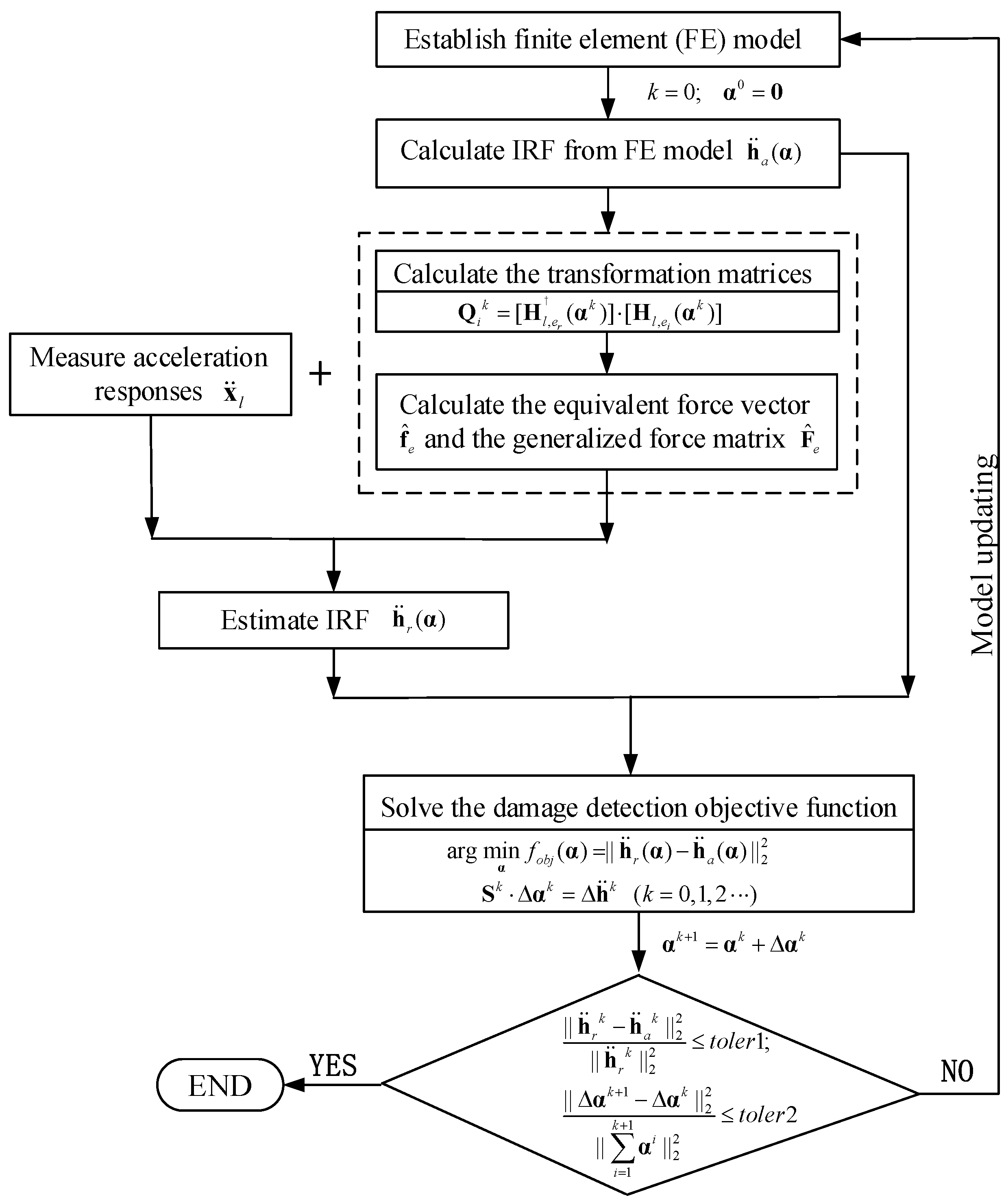

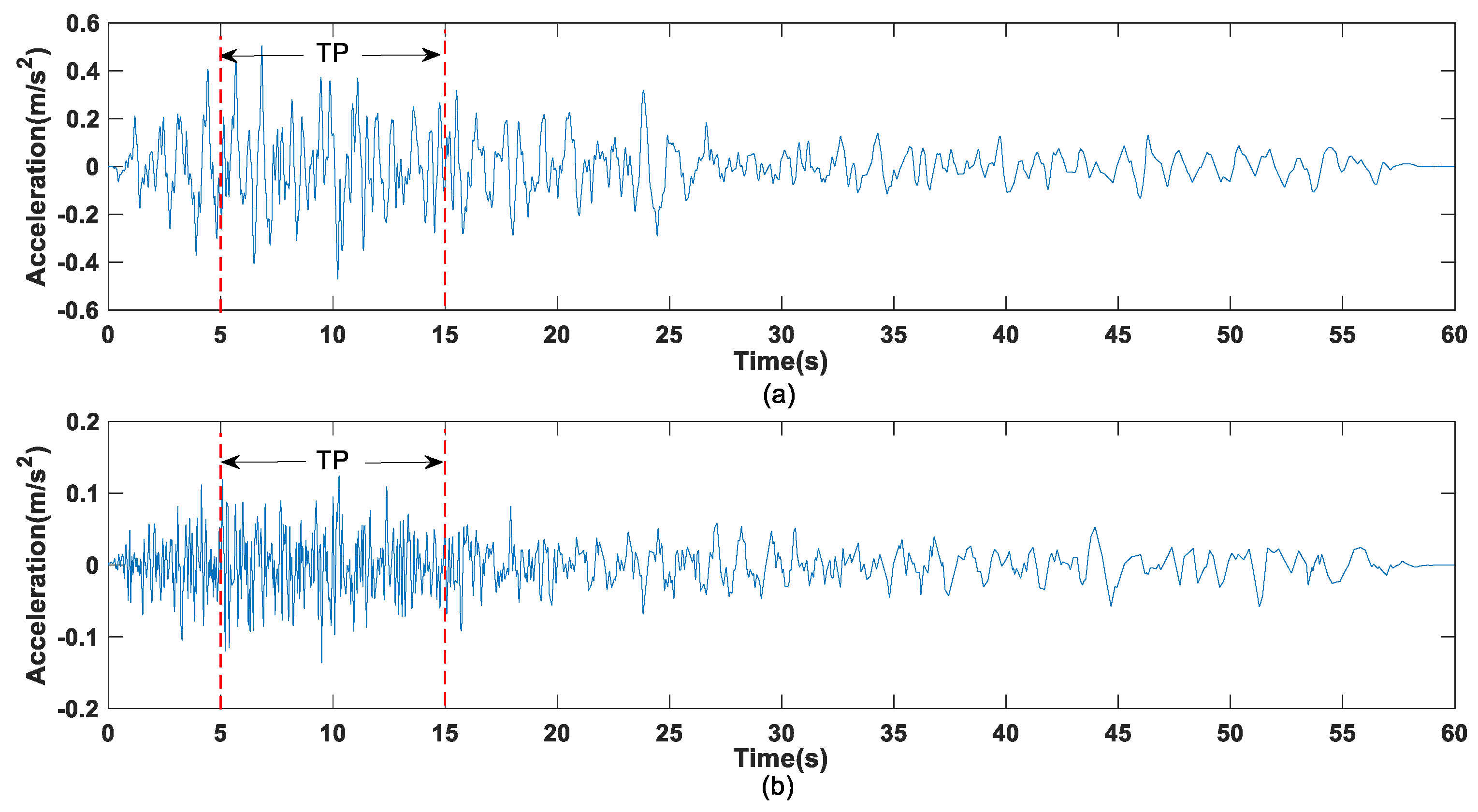
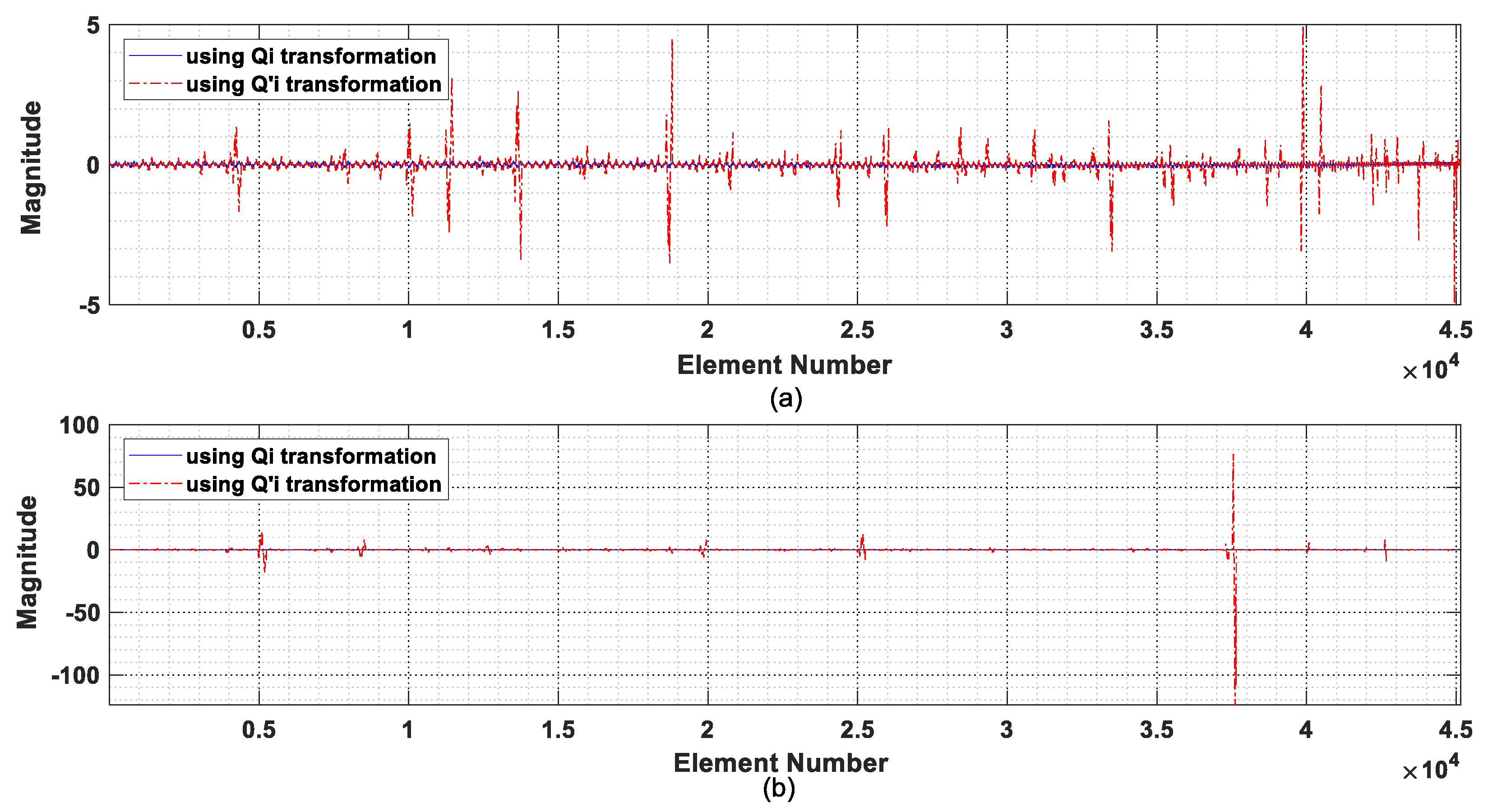
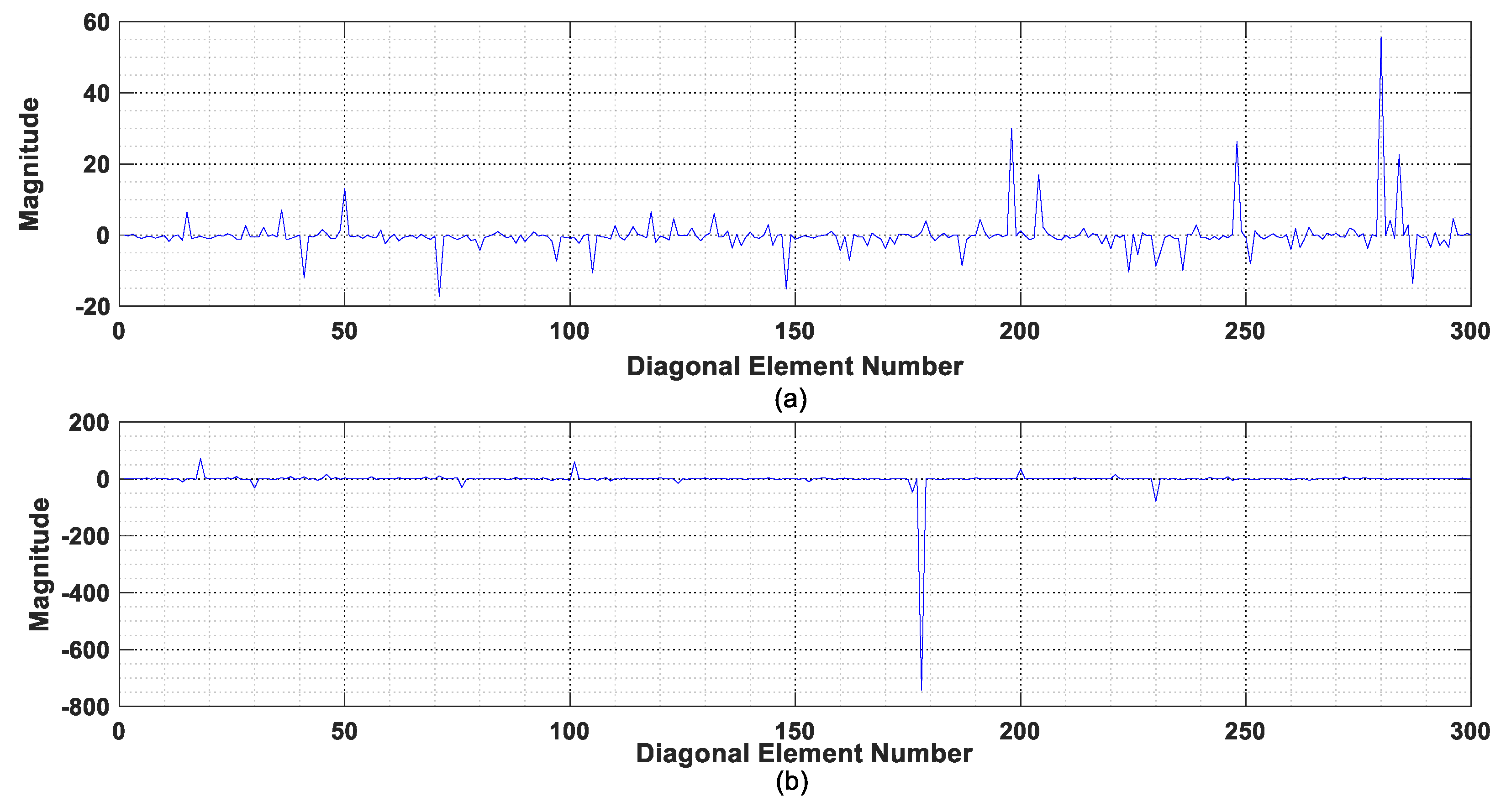

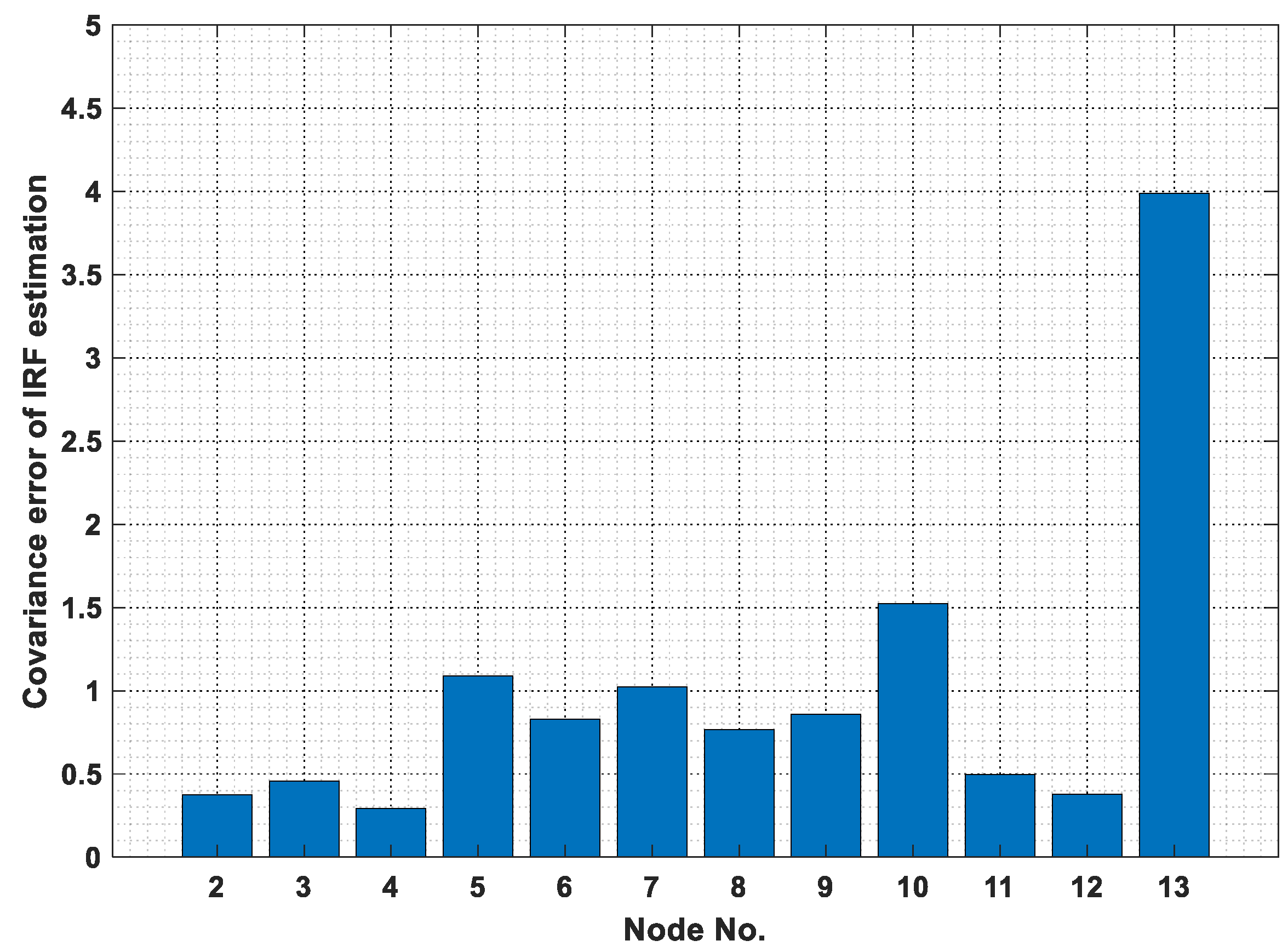

| Scenarios | I | II |
|---|---|---|
| Damage Element No. Damage Extent (%) | 4th (10%) and 5th (15%) | 13th (15%), 15th (10%) and 16th (15%) |
| Sampling Rate (Hz) | 300 | |
| Noise Level (%) | 0, 3 and 5 | |
© 2019 by the authors. Licensee MDPI, Basel, Switzerland. This article is an open access article distributed under the terms and conditions of the Creative Commons Attribution (CC BY) license (http://creativecommons.org/licenses/by/4.0/).
Share and Cite
Lin, J.-F.; Wang, J.; Wang, L.-X.; Law, S.-s. Structural Damage Diagnosis-Oriented Impulse Response Function Estimation under Seismic Excitations. Sensors 2019, 19, 5413. https://doi.org/10.3390/s19245413
Lin J-F, Wang J, Wang L-X, Law S-s. Structural Damage Diagnosis-Oriented Impulse Response Function Estimation under Seismic Excitations. Sensors. 2019; 19(24):5413. https://doi.org/10.3390/s19245413
Chicago/Turabian StyleLin, Jian-Fu, Junfang Wang, Li-Xin Wang, and Siu-seong Law. 2019. "Structural Damage Diagnosis-Oriented Impulse Response Function Estimation under Seismic Excitations" Sensors 19, no. 24: 5413. https://doi.org/10.3390/s19245413
APA StyleLin, J.-F., Wang, J., Wang, L.-X., & Law, S.-s. (2019). Structural Damage Diagnosis-Oriented Impulse Response Function Estimation under Seismic Excitations. Sensors, 19(24), 5413. https://doi.org/10.3390/s19245413





